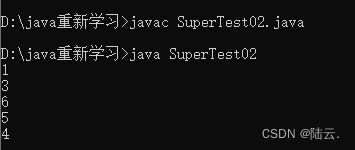Java基础super关键字详解
文章目录
-
- —:super概述:
-
- 示例代码01:
-
- 运行结果:
- 二:super的子类构造方法执行时必然调用父类构造方法
-
- 示例代码02:
-
- 运行结果:
- 三:super实参的用法
-
- 示例代码03:
-
- 运行结果:
- 内存分析图一:
- 示例代码04:
-
- 运行结果:
-
- 内存分析图二:
- 内存分析图三:
- 四:super什么时候不能省略
-
- 示例代码05:
-
- 运行结果:
- 五:super使用后后面必须有个点
-
- 示例代码06:
-
- 运行结果:
- 六:使用super调用父类方法
-
- 示例代码07:
-
- 运行结果:
—:super概述:
1.super能出现在实例方法和构造方法中。
- super的语法是:“super.”,“super()”
- super不能使用在静态方法中
- super. 大部分情况下是可以省略的
2.super();
- 表示通过子类的构造方法调用父类的构造方法
模拟现实世界中的这种场景:要想有儿子,需要先有父亲
2.重要结论:
当一个构造方法第一行:
- 既没有this()又没有super()的话,默认会有一个super(); 表示通过当前子类的构造方法调用父类的无参构造方法, 所以必须保证父类的无参数构造方法是存在的
3.注意
- this()和super()不能共存,它们都是只能出现在构造方法第一行
示例代码01:
public class SuperTest01{
public static void main(String[] args){
new B();
}
}
class A{
//建议手动的将一个类的无参数构造方法写出来
public A(){
System.out.println("A类的无参构造方法!");
}
//一个类中如果没有手动提供任何构造方法,系统会默认提供一个无参数构造方法
//一个类如果手动提供了一个构造方法,那么无参数构造系统将不再提供
public A(int n){
System.out.println("A类的有参构造方法!(int n)");
}
}
class B extends A{
/* public B(){
super(123);
System.out.println("B类的无参数构造方法");
} */
public B(){
super();//调用父类中有参数的构造方法
//super(100);
this("zhangsan");
System.out.println("B类的无参构造方法!");
}
public B(String name){
super(100);
System.out.println("B类的有参构造方法!(String name)");
}
}
运行结果:
二:super的子类构造方法执行时必然调用父类构造方法
在java语言中不管是new什么对象,最后老祖宗的Object类的无参数构造方法
示例代码02:
public class SuperTest02{
public static void main(String[] args){
new C();
}
}
//老祖宗
/* class Object(){
public Object(){
}
} */
class A{
public A(){
System.out.println(1);
}
}
class B extends A{
public B(){
this("zhangsan");
System.out.println(2);
}
public B(String name){
System.out.println(3);
}
}
class C extends B{
public C(){
this("lisi");
System.out.println(4);
}
public C(String name){
this("lisi",5);
System.out.println(5);
}
public C(String name,int a){
super(name);
System.out.println(6);
}
}
运行结果:
三:super实参的用法
1、举个例子:在恰当的时间使用:super(实际参数列表);
2、注意:在构造方法执行过程中一连串调用了父类的构造方法,父类的构造方法又继续向下调用它的父类的构造方法,但是实际上,对象只创建了一个。
3、思考:“super(实参)”到底是干啥的?
- super(实参)的作用是:初始化当前对象的父类型特征。
- 并不是创建新对象。实际上对象只创建了1个。
4、super关键字代表什么呀?
- super关键字代表的就是“当前对象”的那部分父类型特征。
我继承了我父亲的一部分特征:
例如:眼睛、皮肤等.
super代表的就是“眼睛、皮肤等”。
“眼睛、皮肤等”虽然是继承了父亲的,但这部分是在我身上呢。
示例代码03:
public class SuperTest03{
public static void main(String[] args){
CreditAccount ca1 = new CreditAccount();
System.out.println(ca1.getActno() + " " + ca1.getBalance() + " " + ca1.getCredit() + " ");
CreditAccount ca2 = new CreditAccount("123456",500000.0,"123556");
System.out.println(ca2.getActno() + " " + ca2.getBalance() + " " + ca2.getCredit() + " ");
}
}
class Account{
private String actno;
private double balance;
public Account(){
}
public Account(String actno,double balance){
this.actno = actno;
this.balance = balance;
}
public String getActno() {
return actno;
}
public void setActno(String actno) {
this.actno = actno;
}
public double getBalance() {
return balance;
}
public void setBalance(double balance) {
this.balance = balance;
}
}
class CreditAccount extends Account{
//属性:信誉度(诚信值)
//子类特有的一个特征,父类没有
private String credit;
public CreditAccount(){
}
//提供有参数的构造方法
public CreditAccount(String actno,double balance,String credit){
//私有的属性,只能在本类中访问
/* this.actno = actno;
this.balance = balance; */
//以上两行代码在恰当的位置,正好可以使用:super(actno,balance);
//通过子类的构造方法调用父类的构造方法
super(actno,balance);
this.credit = credit;
}
public String getCredit() {
return credit;
}
public void setCredit(String credit) {
this.credit = credit;
}
public CreditAccount(String credit){
this.credit = credit;
}
}
运行结果:
内存分析图一:
示例代码04:
public class SuperTest04{
public static void main(String[] args){
Vip v = new Vip("张三");
v.shopping();
}
}
class Customer{
String name;
public Customer(){
}
public Customer(String name){
super();
this.name = name;
}
public String getName(){
return name;
}
public void SetName(String name){
this.name = name;
}
}
class Vip extends Customer{
public Vip(){
}
public Vip(String name){
super(name);
}
//super和this都不能出现在静态方法中
public void shopping(){
//this表示当前对象
System.out.println(this.name + "在购物!");
//super表示的是当前对象的父类型特征。(super是this指向的那个对象中的一块空间)
System.out.println(super.name + "在购物!");
System.out.println(name + "在购物!");
}
}
运行结果:
内存分析图二:
内存分析图三:
四:super什么时候不能省略
1."this."和“super.”大部分情况下都是可以省略的
2.this.什么时候不能省略?
public void setName(String name){
this.name = name;
}
3.super.什么时候不能省略?
- 父中有,子中又有,如果想在子中访问“父的特征”,super.不能省略
示例代码05:
public class SuperTest05{
public static void main(String[] args){
Vip v = new Vip("张三");
v.shopping();
v.doSome();
}
}
class Customer{
String name;
public Customer(){
}
public Customer(String name){
super();
this.name = name;
}
public String getName(){
return name;
}
public void SetName(String name){
this.name = name;
}
public void doSome(){
System.out.println(this.name + "在购物!"); //张三在购物
System.out.println(name + "在购物!");//张三在购物
//super表示的是当前对象的父类型特征。(super是this指向的那个对象中的一块空间)
// System.out.println(super.name + "在购物!");//编译报错:找不到符号
}
}
class Vip extends Customer{
//假设子类也有一个同名属性
//java中允许在子类中出现和父类一样的同名变量/同名属性
String name;//实例变量
public Vip(){
}
public Vip(String name){
super(name);
//this.name = null;当前对象默认值为空
}
//super和this都不能出现在静态方法中
public void shopping(){
//this表示当前对象
System.out.println(this.name + "在购物!");//null在购物
//super表示的是当前对象的父类型特征。(super是this指向的那个对象中的一块空间)
System.out.println(super.name + "在购物!");//张三在购物
System.out.println(name + "在购物!");//null在购物
}
}
运行结果:
五:super使用后后面必须有个点
super 不是引用。super也不保存内存地址,super也不指向任何对象
super 只是代表当前对象内部的那一块父类型的特征。
示例代码06:
public class SuperTest06{
//实例方法
public void doSome(){
//输出“引用.”的时候,会自动调用引用的toString()方法
System.out.println(this.toString());
//SuperTest06@15db9742
System.out.println(this);
// System.out.println(super);//编译错误:需要“.”
}
//this和super不能使用在static静态方法中
/* public Static void doOther(){
System.out.println(this);
System.out.println(super);
}
*/
//静态方法 主方法
public static void main(String[] args){
SuperTest06 st = new SuperTest06();
st.doSome();
}
}
运行结果:
六:使用super调用父类方法
在父类和子类中有同名的属性,或者说有相同的方法, 如果此时想在子类中访问父类中的数据,必须使用“super.”加以区分。
①super.属性名 【访问父类中的属性】
②super.方法名(实参) 【访问父类的方法】
③super(实参) 【调用父类的构造方法】
示例代码07:
public class SuperTest07{
public static void main(String[] args){
Cat c = new Cat();
c.yiDong();
}
}
class Animal{
public void move(){
System.out.println("Animal move");
}
}
class Cat extends Animal{
//对move进行重写
public void move(){
System.out.println("Cat move");
}
//单独编写一个子类特有的方法
public void yiDong(){
this.move();
move();
//super. 不仅可以访问属性,也可访问方法
super.move();
}
}









